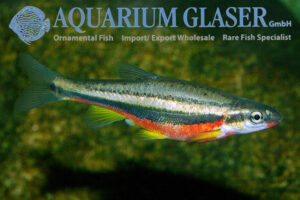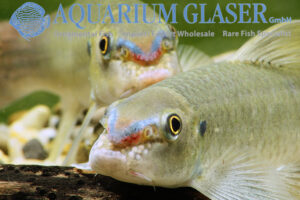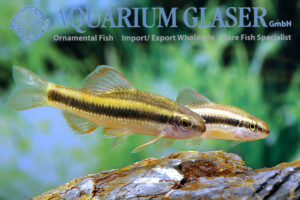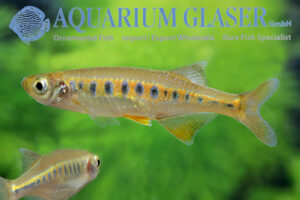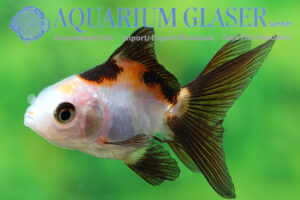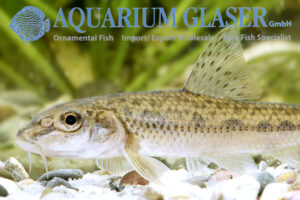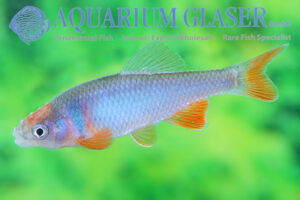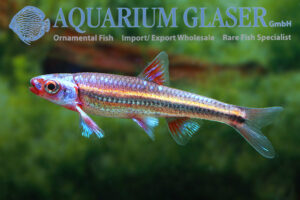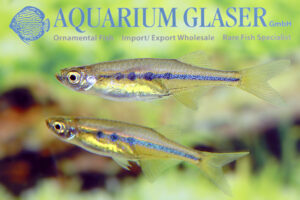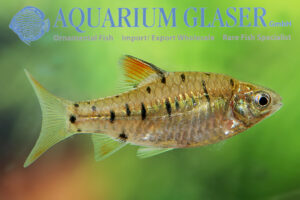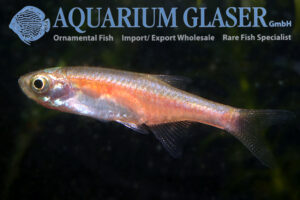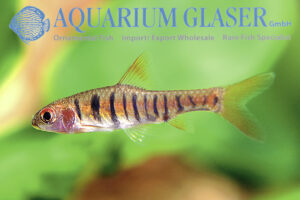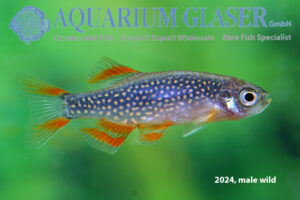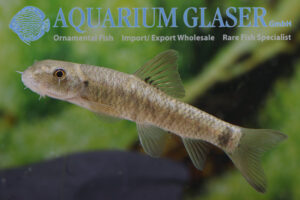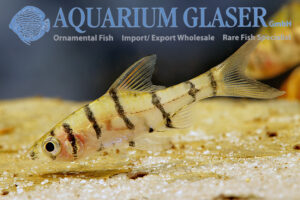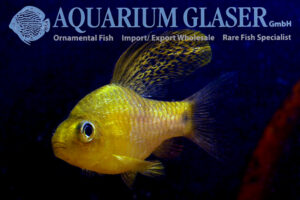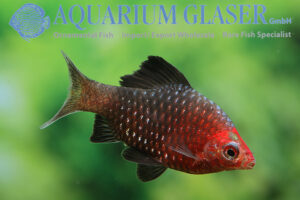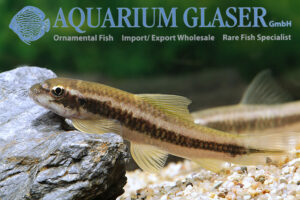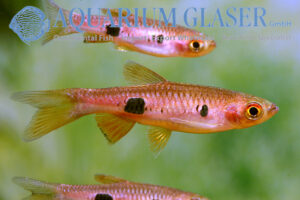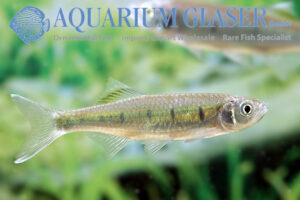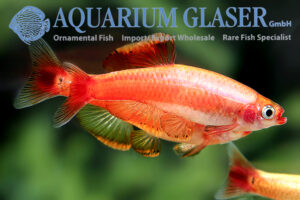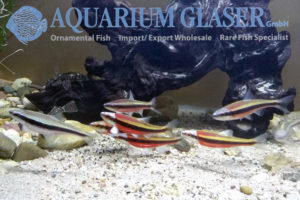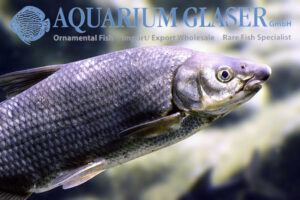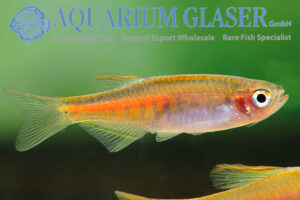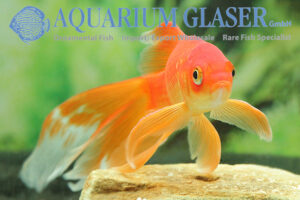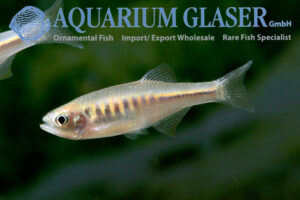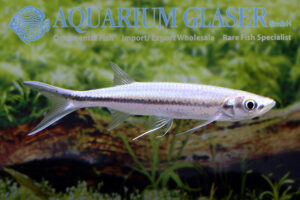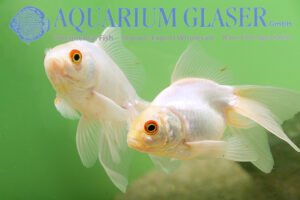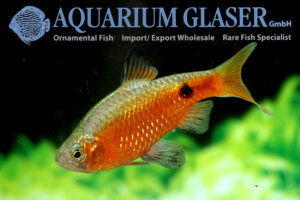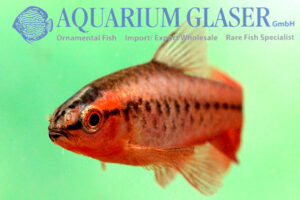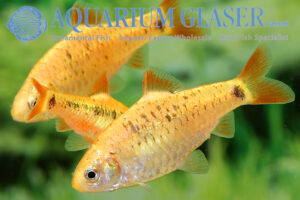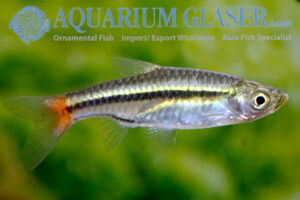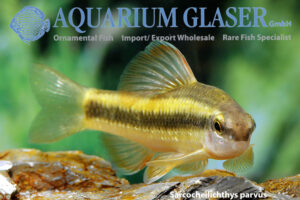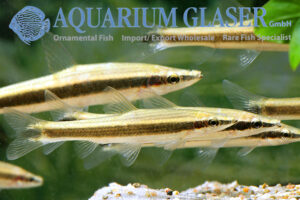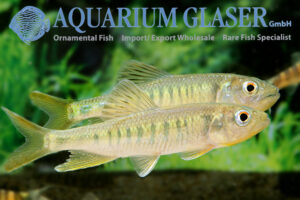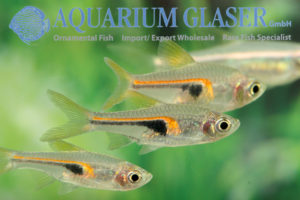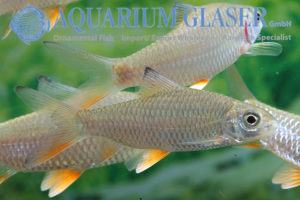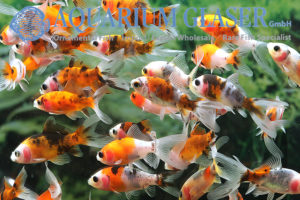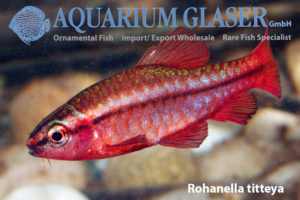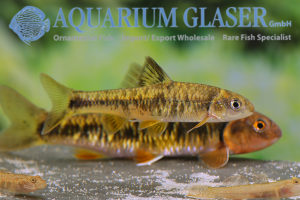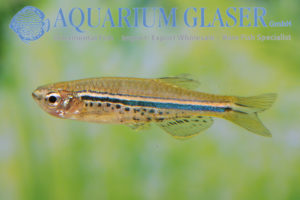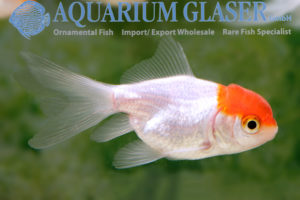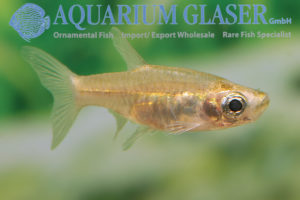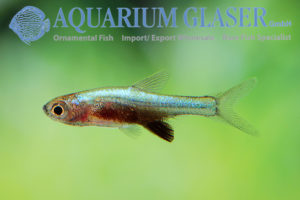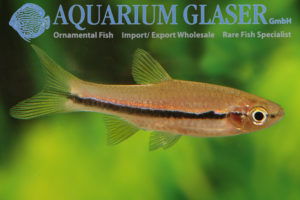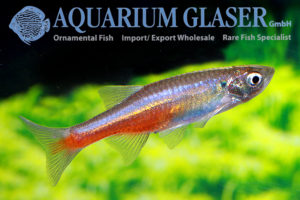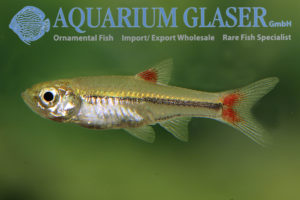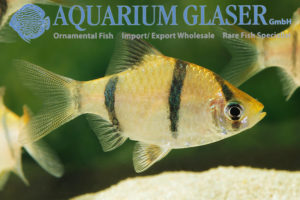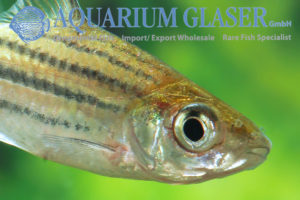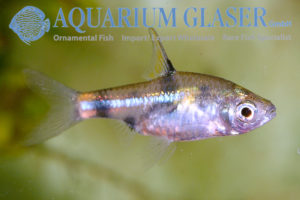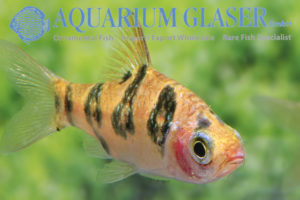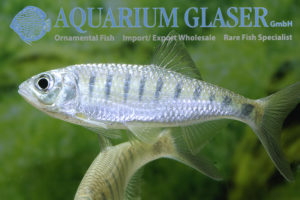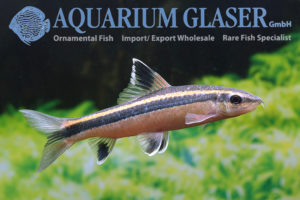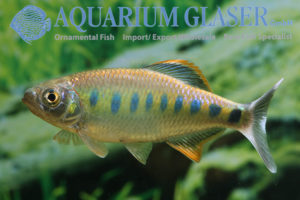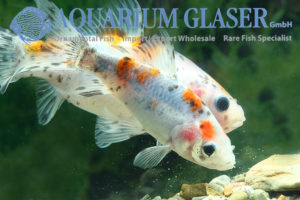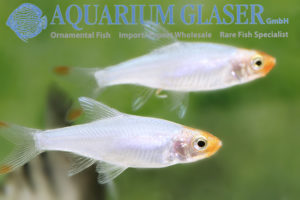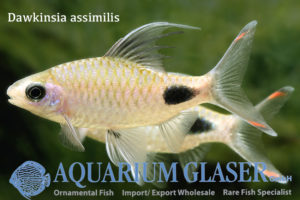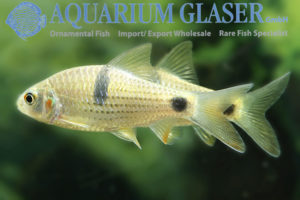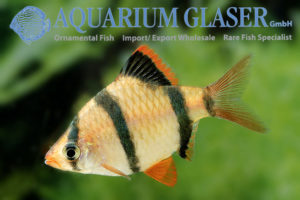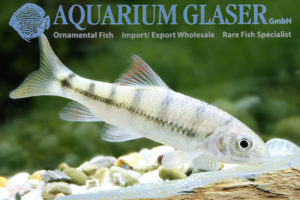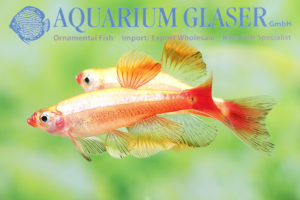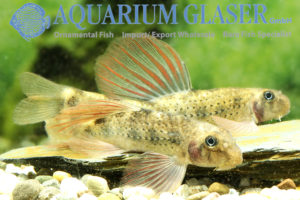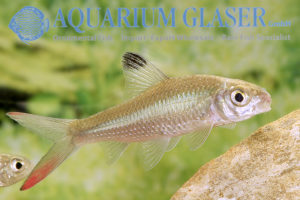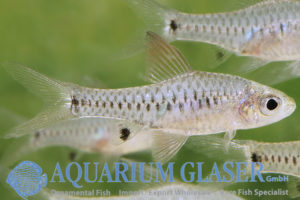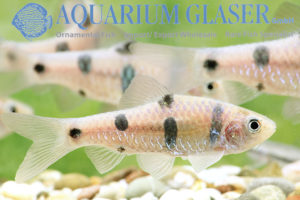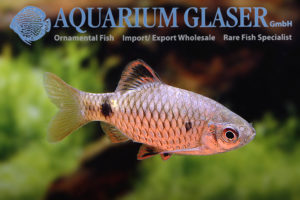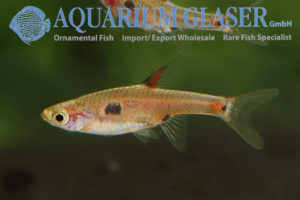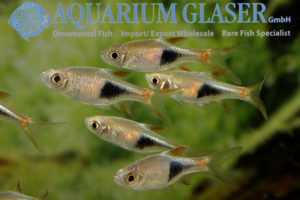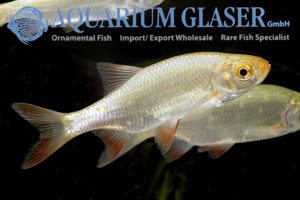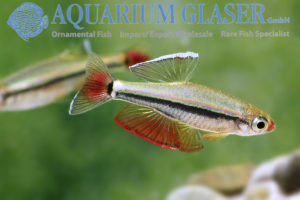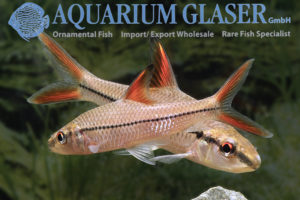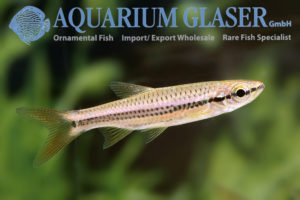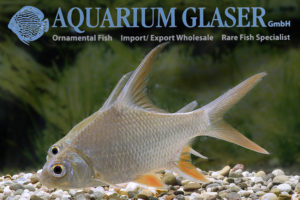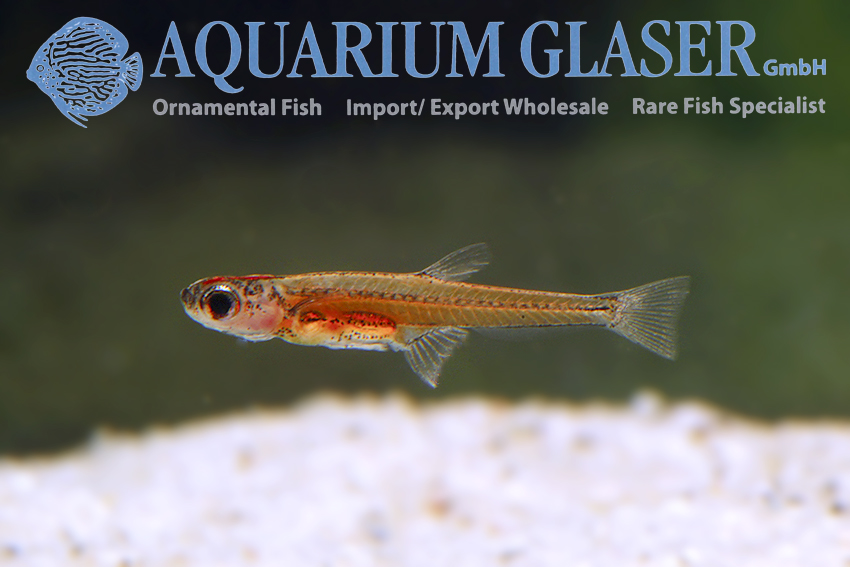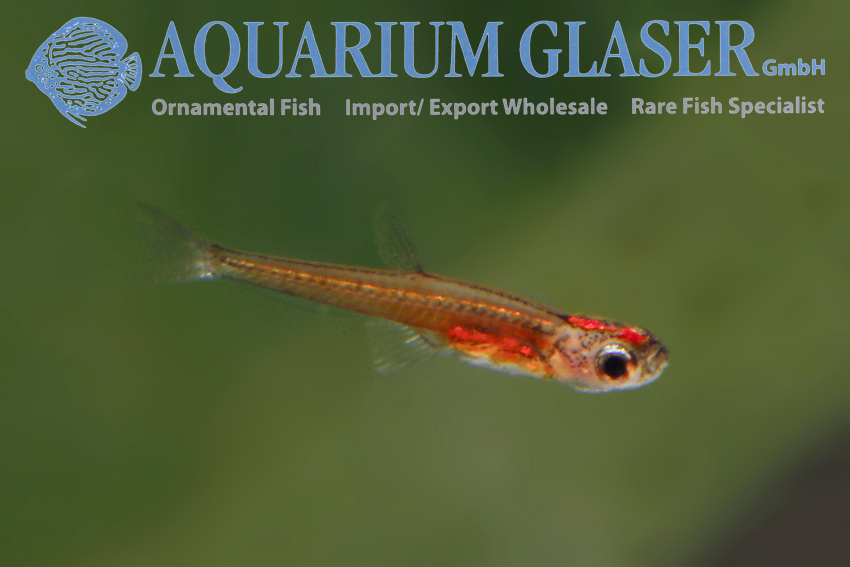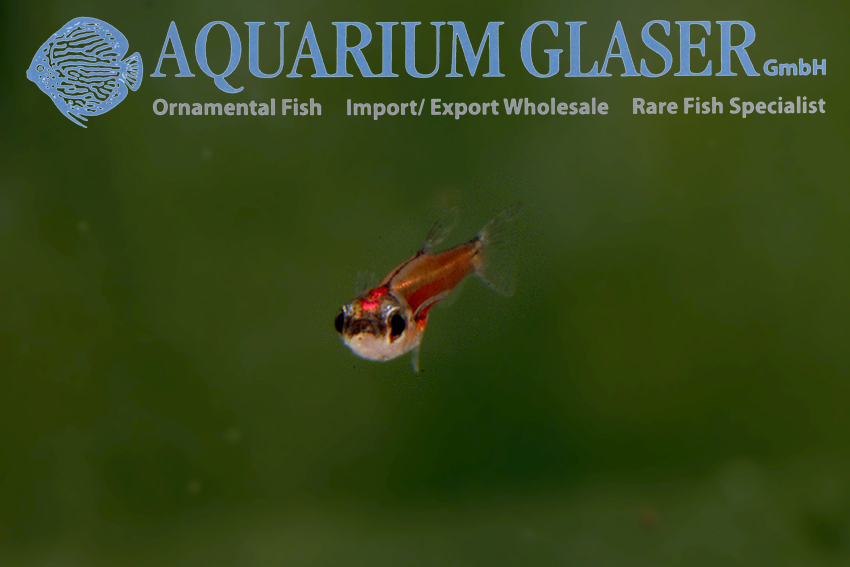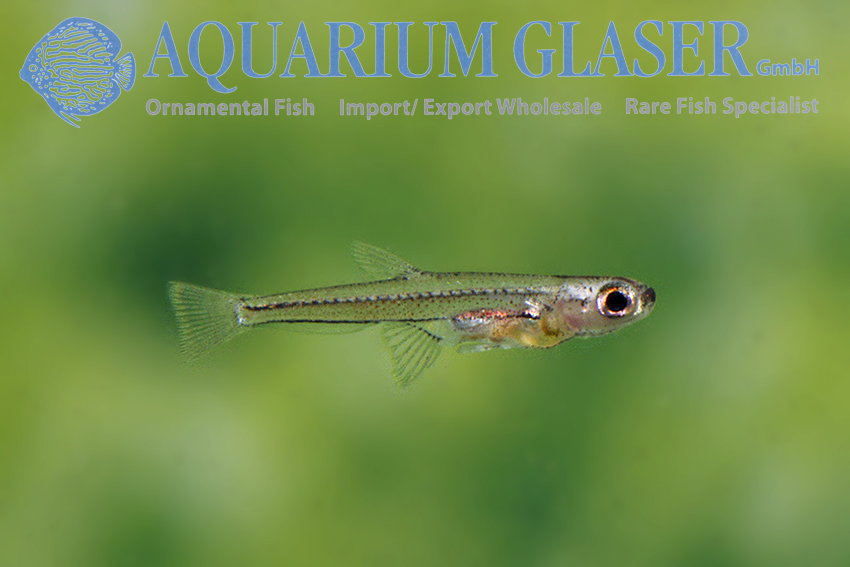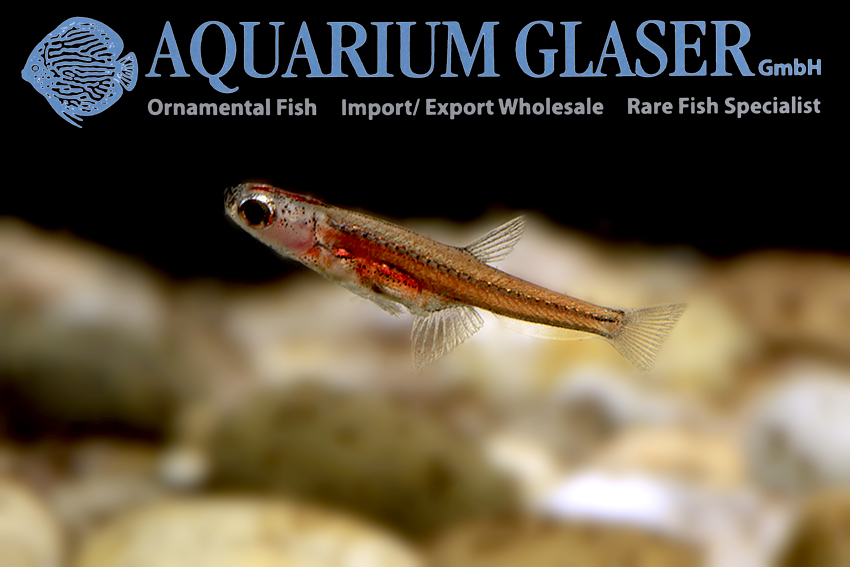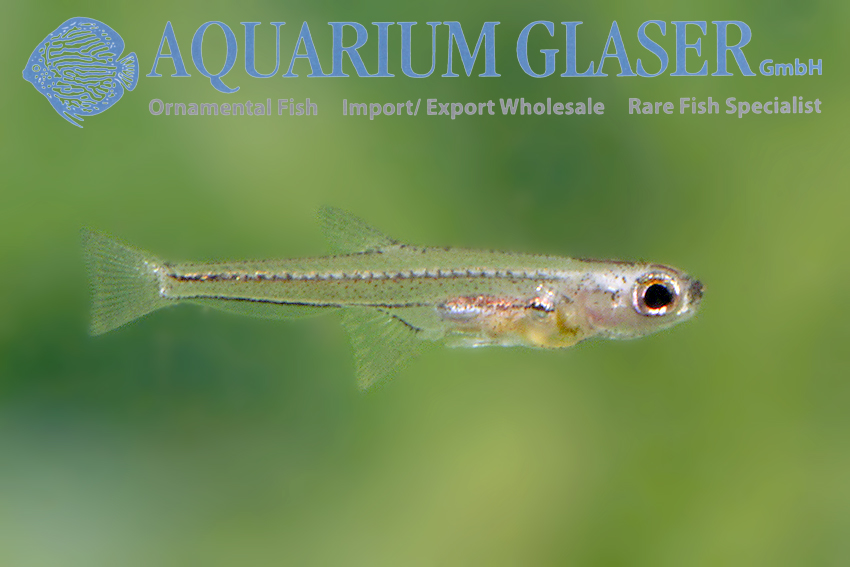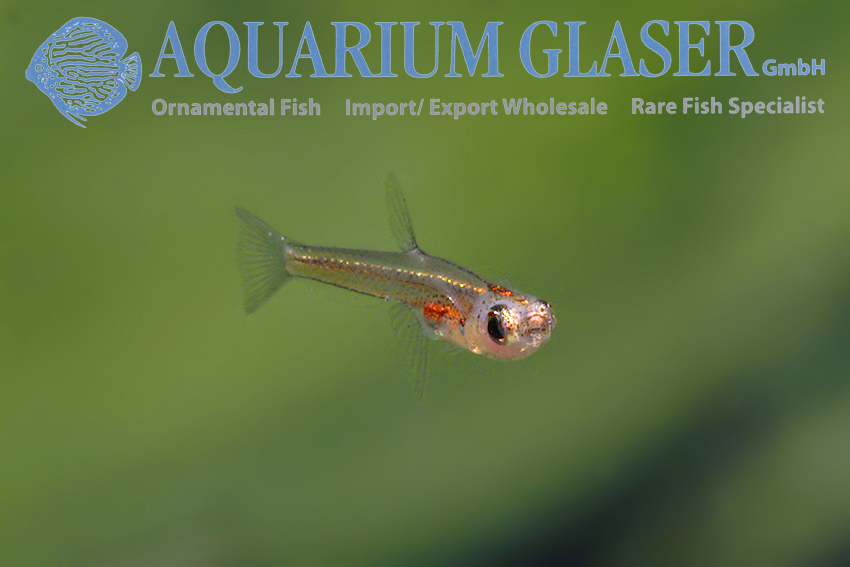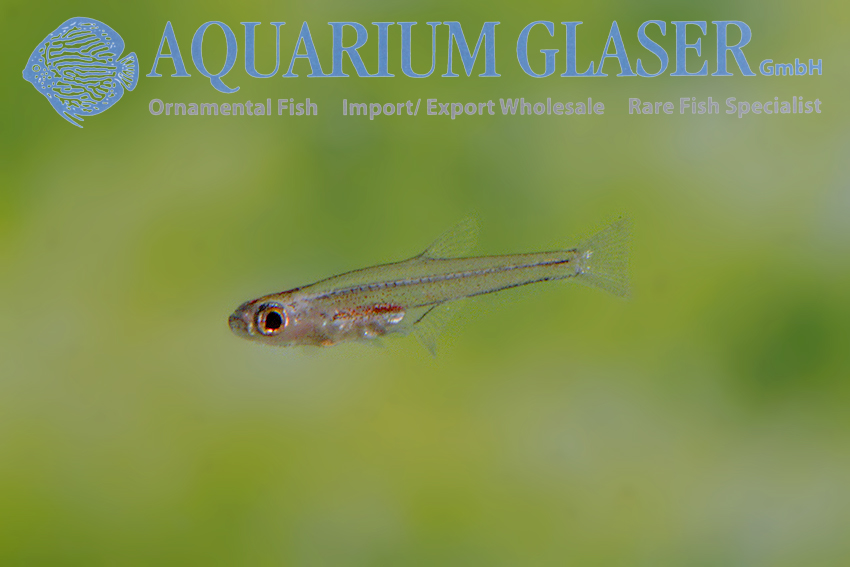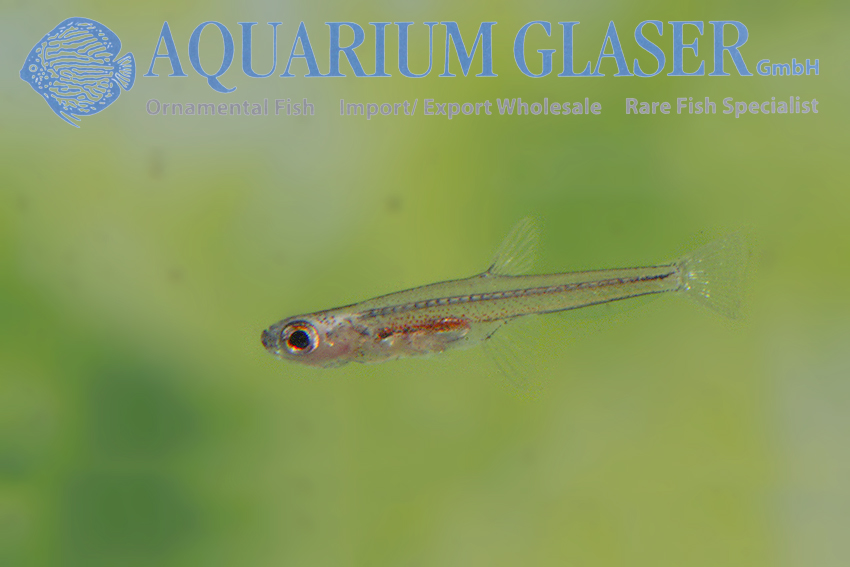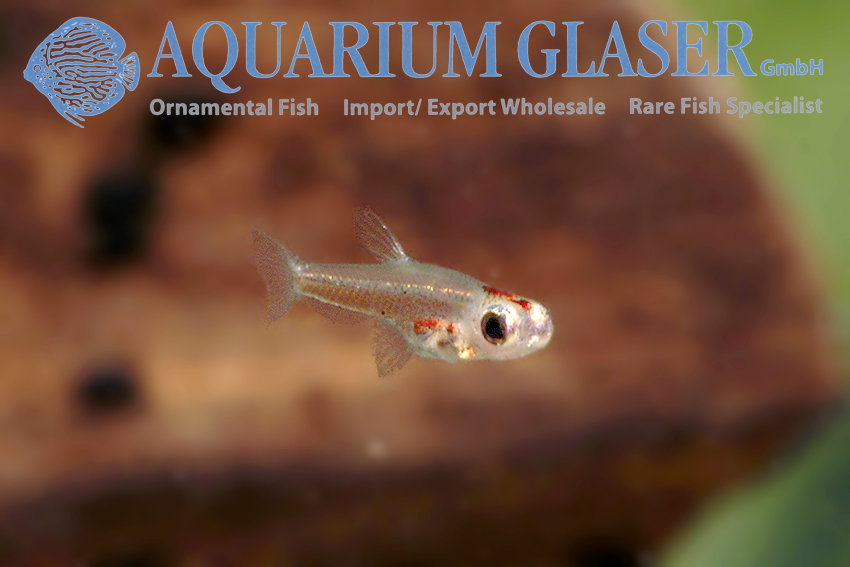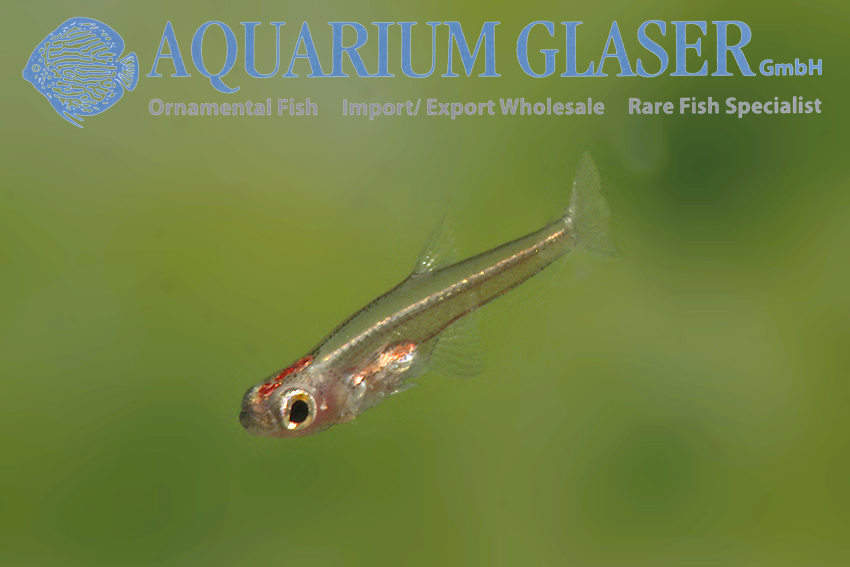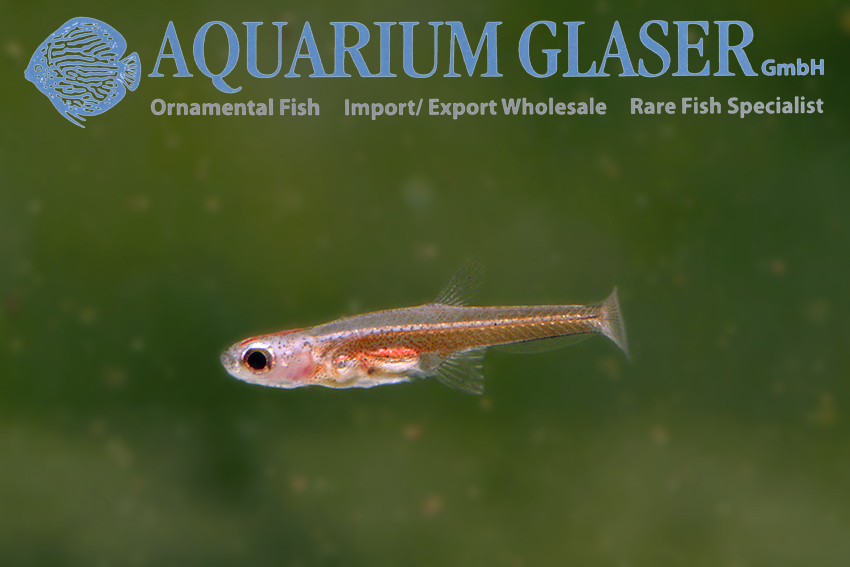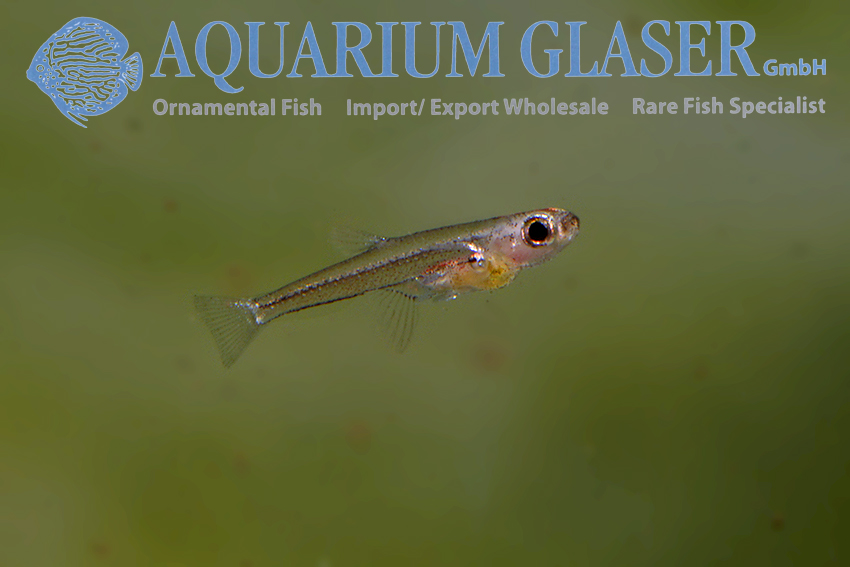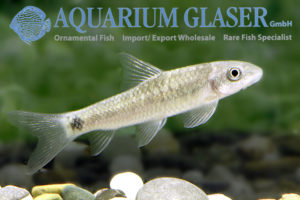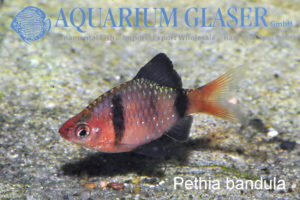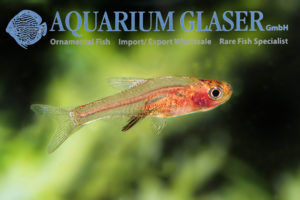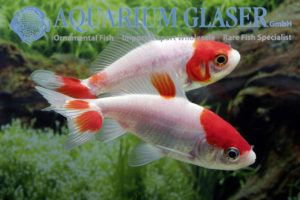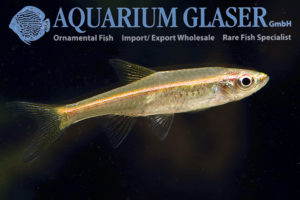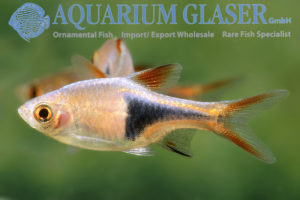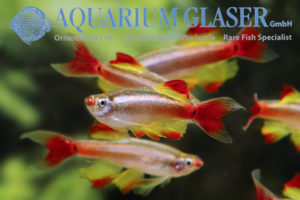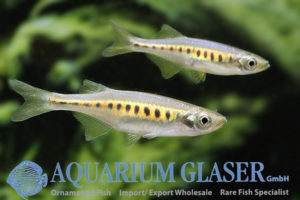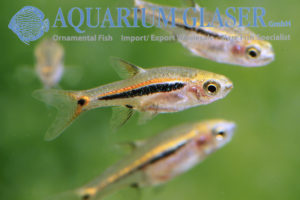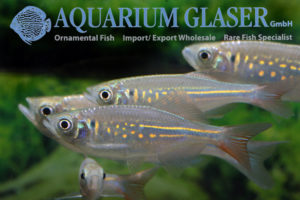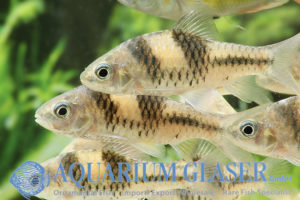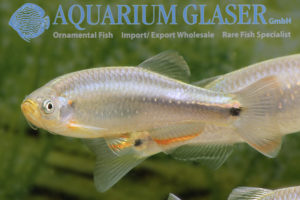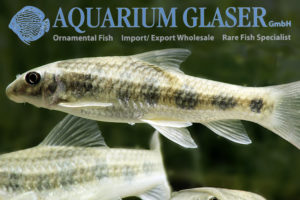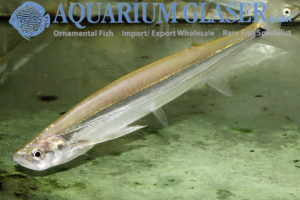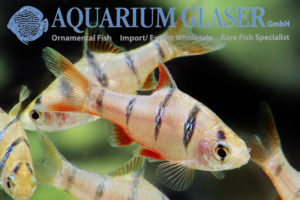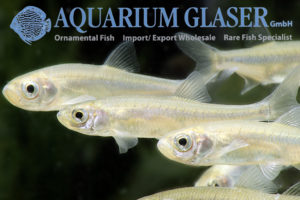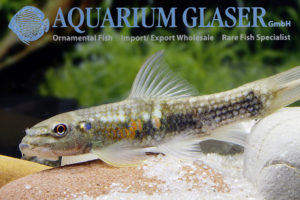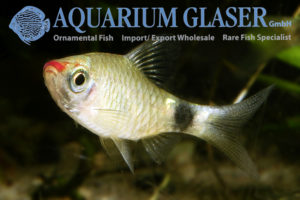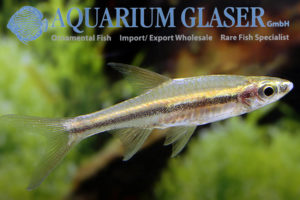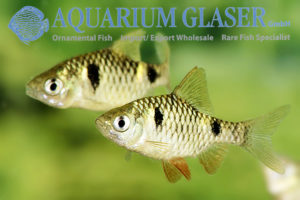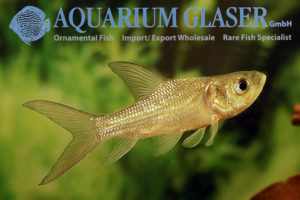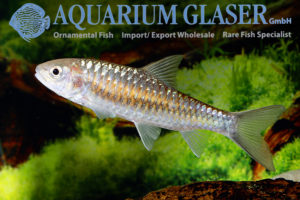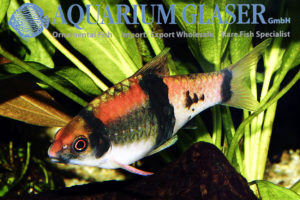Unfortunately, only very few small fish species from the USA are represented in the hobby. One of the species occasionally offered is the very pretty minnow species Chrosomus erythrogaster. This species is widespread in the wild and common in suitable habitats. It is usually found in small mountain streams from Minnesota and western Pennsylvania, south […]
08. Carp like fishes (2): Barbs, minnows, carps, goldfish etc. (254)
-
-
Garra panitvongi ( = sp. Red Tail)
This beautiful sucking barb was scientifically described in 2023 in honor of the meritorious naturalist Nonn Panitvong. Nonn found the animals together with other members of siamensis.org in 2006, so the location (the Kasat River in western Thailand) is well documented. For the history of the discovery of this species, please see https://www.aqualog.de/blog/garra-sp-rotschwanz-godzilla-kommt-vom-kasat-river/ The article […]
-
Rasbora daniconius
From India we were able to import Rasbora daniconius, This minnow usually grows to 6-8 cm in length, the largest specimen ever measured supposedly measured 15 cm. The species is found in Bengal together with such well-known and popular ornamental fishes as zebra danio (Danio rerio), rosy barb (Pethia conchonius), dwarf gourami (Colisa lalius) and […]
-
Trigonostigma espei
Of the five species currently assigned to the genus Trigonostigma (harlequin barbs) – the well-known common harlequin barb T. heteromorpha, the most recently described T. truncatus, the dwarf T. somphongsi, T. hengeli and T. espei – the last two are often confused; unfortunately, this also happens to us from time to time if we are […]
-
Sarcocheilichthys parvus
The genus Sarcocheilichthys from China has the potential to become a new star in the ornamental fish sky. There is a complex of small (6-7 cm) species within the genus in southern China, which are characterized by a broad longitudinal band. The males of all three species develop very pretty vermilion fins at spawning time. […]
-
Inlecypris auropurpureus
Lake Inle in Burma has a high proportion of endemic fish species, i.e. those that are found exclusively there. One of these is Inlecypris auropurpureus, a Danio with vertical stripes on a golden band. The number and shape of the stripes are slightly different in each individual. Inlecypris is closely related to the malabar danio […]
-
Carassius auratus – Goldfish Oranda Tricolor
The breeding of certain goldfish is one of the most demanding of all breeding activities – if it is done consciously. This is because characteristics such as coloration, finning, eye and skin changes in goldfish are usually not controlled by a single gene, but by several genes. This also affects the expression, i.e. larger or […]
-
Gobio gobio, gudgeon
The gudgeon, Gobio gobio, is one of the smallest native fish. It usually grows to 8-12 cm, rarely over 15 cm long. The record is said to be 21 cm, but such giants are as rare as people over 2.20 m long. Because of its small size and pretty colouring (compared to the mostly silvery […]
-
Cyprinella lutrensis
There are numerous species (approx. 320) of minnow relatives in North America, but only very few species have become aquarium fish to date. In contrast to our native minnow, the Red Shiner (Cyprinella (formerly: Notropis) lutrensis) is a fairly undemanding fish and does not require such low temperatures. Although the species can be kept in […]
-
Hydrophlox chrosomus ( = Notropis chrosomus)
The “rainbow shiner” (Hydrophlox chrosomus, formerly Notropis c.) was a sensational fish in the early 2000s. Strangely enough, only very few of the almost 325 species of North and Central American minnows and shiners have ever become established as aquarium fish. The fact that these animals are highly complex from a systematic-taxonomic point of view […]
-
Neochela dadiburjori ( = Laubuka dadiburjori, = Chela dadiburjori)
This nano-fish jewel comes from the south of India (Kerala); the delightful dwarfs grow to a maximum length of 3 cm. They are absolutely peaceful schooling fish that prefer to spawn on the upper side of broad leaves, especially on Ludwigia species. However, they also show an amazing ability to adapt. About 50 years ago, […]
-
Barbodes semifasciolatus ( = Barbus s.)
The Chinese barb (Barbodes semifasciolatus) was one of the first “exotic” ornamental fish to be kept in aquaria. Under the completely misleading name “Japanese bitterling”, they were introduced and bred as early as 1897 in the then still young aquarium hobby. In the first known article on the species (May 1897 in the “Blättern für […]
-
Microrasbora rubescens
This dwarf rasbora – it only reaches a total length of 2-3 cm – is right in line with the current trend. There have always been fashions in aquaristics, just like in any other hobby. Sometimes it’s the characins, then it’s the Malawi cichlids or the discus, the L-catfish or the West African dwarf cichlids. […]
-
Enteromius fasciolatus ( = Barbus fasciolatus, Barbus barilioides)
Only very few of the numerous small barb species in Africa have been able to establish themselves permanently as aquarium fish and only one species is bred so regularly that it is more frequently found in the pet trade. This species is the beautiful Angola barb, Enteromius fasciolatus. A well-known synonym of the species is […]
-
Celestichthys margaritatus ( = Danio m.)
It was the sensation of 2006: the galaxy rasbora (Celestichthys margaritatus). The species was still scientifically unknown at the time of its discovery. Just one year later, in 2007, Tyson Roberts described this 2 – 2.5 cm long fish jewel from Burma under the scientific name Celestichthys margaritatus and established the new genus Celestichthys. This […]
-
Garra rufa
The Kangal psoriasis fish (Garra rufa) has become famous because the population of this species, which is widespread in the Middle East, living in the Turkish Kangal thermal baths can be used to provide relief for people suffering from serious skin diseases (neurodermatitis, psoriasis, etc.). This is due to the fact that this sucking barb […]
-
Eirmotus furvus
The delicate and sensitive barbs of the genus Eirmotus are very poorly researched. The first discovered species – E. octozona – was described on the basis of a single specimen that came from the trade. It allegedly came from Bung Borapet in Thailand. Since then, no Eirmotus has ever been found in Thailand. Instead, they […]
-
Oreichthys crenuchoides
The Hifin barb is a very unusual representative of its kind. The original home of this small species, which only grows to 3-4 cm long, is in the north of India, in Assam and northern Bengal. There it inhabits slowly flowing waters. The males of O. crenuchoides develop a huge, sail-like dorsal fin. This fin […]
-
Pethia nigrofasciata
The black ruby barb (Pethia nigrofasciata) is one of the most popular ornamental fish of all. This beautiful fish, which grows to around 5-6 cm long, is endemic to Sri Lanka (i.e. only found there). There, the species prefers to colonize flowing waters in the southwest of the island, from the catchment areas of the […]
-
Garra ceylonensis
After 10 years we once again have the sucker barb Garra ceylonensis on offer. This species is endemic to Sri Lanka, so it only exists there. Wild fish from Sri Lanka may only be exported with a special permit. Our suppliers of ornamental fish from Sri Lanka had not previously applied for this permit because […]
-
Rasbora kalochroma
One of the undoubtedly most beautiful Rasbora species is R. kalochroma – and one of the most sensitive. They are typical black water fish which react very sensitively during the acclimatisation phase to increased bacteria contamination, which occurs almost inevitably in “normal” water. When we were now offered youngsters, we took advantage, because young fish […]
-
Opsarius koratensis
Typical open water fish are very rarely kept in the aquarium. There is a simple reason for this: they are usually quite colorless. The Opsarius koratensis, which can grow to a maximum length of 10-12 cm (some sources even state 16 cm), is no exception. However, keeping these fish can still be very rewarding, as […]
-
Tanichthys albonubes Gold-Red
A new breeding form of the well-known white cloud: Gold-Red. It is very interesting that you can recognize all possible intermediate stages of the two parent forms by this not yet completely bred form: the golden white cloud, which shows mostly black pigmentation in the belly area with a basically yellowish body coloration, and the […]
-
Notropis lutipinnis
The small fishes of North America are rather unknown in Europe. Yet the genus Notropis alone includes 91 accepted species! Many of them are very colorful at spawning time. In their native country Notropis species are called “shiners” in the sense of a shining object, so much do the colors of these fish shine. But […]
-
Chondrostoma nasus
The nase (Chondrostoma nasus) is a carp fish, usually 25-30 cm, maximum 50 cm long, which is native to Central Europe and Western Asia. As the species has relatively high demands on water quality, populations have declined sharply in many places, but the nase is currently considered „least „concern“ overall. Unfortunately, nase has also been […]
-
Danio choprae ( = Danio choprai)
Danio choprae, also known as the ruby or glow-light danio, comes to us from rivers and streams in Myanmar. At a length of 4 cm, they are already fully grown. As with many schooling fish, the effect on the observer increases with the size of the school. A group of 30 animals roaming lively through […]
-
Carassius auratus Goldfish Comet red
Spring is approaching and with it the garden pond season. The simple goldfish breeding forms are best suited to this for a number of reasons, while high breeders (Oranda and Co.) have special requirements. But even with the “simple” forms – i.e. normal goldfish, comets, shubunkin and wakin – it is important to note that […]
-
Devario maetaengensis ( = Danio m., = Inlecypris m.)
The Danios are a very species-rich group of small to medium-sized carp fish, usually less than 10 cm in length. Most species have bright, iridescent colors and are excellent aquarium fish, some of which are standard in the global ornamental fish trade. The variety of forms makes it extremely difficult to get a complete overview […]
-
Luciosoma setigerum
The barb Luciosoma setigerum with the extremely aerodynamic shape originates from Indonesia. Despite the size the fish can reach – up to 25 cm – the peaceful and splendid colored fish is an ideal inhabitant for a community tank with other large barbs from Asia, like Bala sharks (Balantiocheilus) or Sahyadria denisonii. For our customers: […]
-
Veiltails – as colorful as Easter eggs
Easter is just around the corner, it’s getting warmer. Goethe has his Dr. Faust say on his Easter walk: “From the ice they are freed, the stream and brook, By the Spring’s enlivening, lovely look;” (translation by Edgar Alfred Bowring, 1853) and this also applies to garden ponds. For many, garden pond time is also […]
-
Pethia conchonius (formerly Barbus or Puntius conchonius)
The rosy barb (Pethia conchonius) was first brought to Germany in 1903 and has since developed into a worldwide classic among ornamental fish. It is one of the 100 most commonly traded species. They are hardly ever wild-caught, although these fish are so common in their native country India that they are traded in large […]
-
Rohanella titteya (formerly Barbus or Puntius titteya)
The cherry barb has recently been assigned a new genus (see https://www.aquariumglaser.de/en/08-carp-like-fishes-2-barbs-minnows-carps-goldfish-etc/new-generic-names-for-former-puntius/). In the genus Rohanella – named in honor of Rohan Pethiyagoda, one of the most prominent ichthyologists of our time – there is only one species, R. titteya. DNA studies have shown that the different geographical locality variants are not genetically far enough […]
-
Barbodes “schuberti”
Brocade is a very heavy, strong fabric. It used to be considered particularly noble and precious, as the base fabric was made of silk and gold and silver threads were woven into it. All in all, brocade was a fabric for ceremonial robes and similar purposes. The golden barb is called brocade barb in German […]
-
Rasbora borapetensis
The blackline rasbora is a well-known aquarium fish that has been delighting ornamental fish enthusiasts since 1954. This completely peaceful schooling fish is ideal for enlivening the middle and upper water layers. Rasbora borapetensis, whose species name was chosen after the place where it was first found (the 220 km2 Bung Borapet swamp in Thailand), […]
-
Sarcocheilichthys parvus
The genus Sarcocheilichthys from China has the potential to become a new star in the ornamental fish sky. There is a complex of small (6-7 cm) species within the genus in southern China, which are characterized by a broad longitudinal band. The males of all three species develop very pretty vermilion fins at spawning time. […]
-
Pseudorasbora elongata
The genus Pseudorasbora comprises only five accepted species. Representatives of the genus can be easily recognized by the upwardly directed mouth fissure, a characteristic that is rare within the carp fish (Cyprinidae). Pseudorasbora is originally distributed in East Asia (China, Russia, Japan). One species, P. parva, was unintentionally introduced in the 1970s with food fish […]
-
Opsariichthys cf. songmaensis
From Vietnam we were able to import dragonfishes, which we first – at a superficial view – thought to be Zacco platypus. Then we looked a little bit closer and there were differences. First of all Zacco platypus has clearly wider body bands. So we started to do some research and that’s when it got […]
-
Trigonostigma hengeli
Currently there are 5 species of harlequin barbs (Trigonostigma) scientifically named and accepted: the “classic” harlequin barb (T. heteromorpha), plus T. hengeli, T. espei, T. somphongsi and T. truncata. However, genetic studies showed that there are even more species. An exciting topic! From the great Sunda Islands of Sumatra and Borneo comes the glowlight harlequin […]
-
Hypselobarbus jerdoni
We have received again some juveniles of the very rarely imported large barb Hypselobarbus jerdoni. It is an endemic species of southern India, where it is found in the states of Karnataka and Kerala. With a maximum final length of 50 cm, H. jerdoni is only suitable for really large aquariums. Here the current-loving, peaceful […]
-
Carassius auratus Shubunkin multicolored 4-6 cm
The juveniles of all goldfish breeds are wild colored up to a length of about 4 cm, i.e. gray-green with a brass sheen. That is why there are never very small goldfish in the trade. The first juveniles from this spring have now colored up and are available, a very good opportunity for those who […]
-
New generic names for former Puntius
Up to 120 species of Asian small barbs were formerly assigned to the genus Puntius. It was already clear for decades that Puntius is not a real relationship group, but a collective pot for most different small barb groups. That is why many even preferred the classification of the Asian small barbs with Barbus, just […]
-
Sarcocheilichthys davidi
With the energy crisis, fish species that do not require supplemental heating are increasingly becoming the focus of attention. Among these species is Sarcocheilichthys davidi, a bottom-oriented carp fish from China found in the Yangtze River basin. This species grows to a maximum size of 10 cm. Our first thought when we unpacked the fish […]
-
Danio nigrofasciatus
The spotted danio (Danio nigrofasciatus) originates from Burma (Pegu and Mulmein) and is a close relative of the zebra danio (Danio rerio), to which it is completely similar in behavior. However, the spotted danio remains somewhat smaller with a maximum total length of 4 cm. The cute schooling fish come from subtropical regions; in winter […]
-
Oranda Red Cap
One of the most popular goldfish breeds is the Oranda Red Cap. Its name is a Japanese corruption of the word for “Dutchman”, because the first Orandas came to Japan via a Dutch trading post in 1800; however, the animals were bred in China. The hood, called “wen” in technical jargon, is – technically speaking […]
-
Horadandia brittani: A Dwarf from India
At the moment we can again offer Horadandia from South India (Kerala). This miniature fish is also known as the dwarf fire rasbora, as they are closely related to the fire rasboras of the genus Rasboroides. Horadandia reach only a length of 1,5-2 cm. For a long time it was believed that there was only […]
-
Sundadanio cf. axelrodi Blue ( = Rasbora sp. aff. axelrodi BLUE)
The tiny dwarfs of the genus Sundadanio were listed in the genus Rasbora until 1999. At that time only one species was known, namely S. axelrodi. Later other species were imported. They were still nameless, but clearly differed in color. Thus, there were blue, green and red Sundadanio. In 2011 the genus was revised and […]
-
Rasbora einthovenii
A typical companion fish of harlequin barbs (Trigonostigma), chocolate gouramis (Sphaerichthys) and other blackwater fish is Rasbora einthovenii. The species is unfortunately very rarely imported, although it has a large range. It is found on the large Sunda islands of Sumatra and Borneo, on the Malay Peninsula and in southern Thailand in suitable biotopes. Usually […]
-
Devario sondhii
This beautiful danio comes from Burma. It looks like the big brother of Microrasbora rubenscens. Males become wonderful red. Temperature: 18-28°, the water should preferably be rather hard and alcalic than soft and acidic, the fish is a peaceful schooling fish that attains a maximum length of around 5-7 cm. For our customers: the fish […]
-
Rasbora rubrodorsalis
From Thailand we just received once again the dwarfish brilliant redfin rasbora, Rasbora rubrodorsalis. This species was recognized as a distinct species only late, in 1997, although it is widely distributed in Southeast Asia (Laos, Cambodia, Thailand, Vietnam). It was formerly thought to be a juvenile form of the similar species Rasbora borapetensis. Unlike R. […]
-
Puntigrus tetrazona – the true tiger barb
We have now been able to import genuine tiger barbs from Central Sumatra (Jambi Province) as wild-caught specimens. When looking at the pretty and extremely lively animals, it is immediately clear that it is something other than the “aquarium tiger barb”. We are very happy that we succeeded in importing this “real” tiger barb, eg […]
-
Striuntius lineatus
Only in very few cases is such confusion around fish names as there is around the horizontically striped barbels of Southeast Asia. The beautiful animals belong according to current opinion to two genera: the species with clearly visible, long barbels belong to the genus Desmopuntius with currently seven accepted species and the form without (or […]
-
Pethia gelius
The golden barb (Pethia gelius) is an aquarium old-timer that found friends even before the First World War. It is one of the smallest barb species in India. Males rarely grow longer than 2.5 cm, females slightly larger. The record of 5 cm total length, which has been haunting the literature for decades, is probably […]
-
Desmopuntius rhomboocellatus
Once again we have been able to import beautiful, fully grown specimens of the Orange Barb; unfortunately they are already sold out, but we want to use this opportunity to point out another of the numerous name changes of the Asian small barbs. Desmopuntius – the name means “convict barb” and refers to the striped […]
-
Opsarius barna
If you like Danios you will love Opsarius! They are lively, very elegant swimmers, more similar in behavior and appearance to trout than to other danios. As a popular collective name for the group, which includes the genera Opsarius, Barilius, Raiamas and Opsariichthys with a total of about 70 species in Asia and Africa, “Trout […]
-
Boraras merah
Currently we have very nice Boraras merah in stock. The species is a very close relative to B. brigittae and at least in some populations the females of B. merah look like B. brigittae and only the males have a typical B. merah pattern (see also http://www.aquariumglaser.de/en/boraras-brigittae–boraras-merah_de_1107.html). Cross-breeding experiments also show that both varieties are […]
-
Epalzeorhynchos kalopterum
The Flying Fox, Epalzeorhynchos kalopterum (Epalzeorhynchos is neuter, so if the species name is an adjective – as in this case – it must end in the Latin neuter suffix -um), originates from Indonesia, Malaysia and Thailand, where it is a resident of flowing waters that carry deep dark brown black water. They are probably […]
-
Barilius ardens
Fishes of the genus Barilius are ecologically best compared to trout in the Indian region, where they do not naturally occur. Barilius thus prefer to live in clear waters with a gravelly bottom and some current. They are mostly seen in loose groups, they are not really schooling fish. They like to “play” among themselves, […]
-
Shubunkin
It is and remains the oldest ornamental fish in the world: the goldfish (Carassius auratus) and its many cultivated forms. It has been propagated and kept by humans for about 1,000 years. Many consider goldfish to be garden pond fish, especially the varieties with “nomal”, wild fish-like body types. This is quite true, and they […]
-
Sawbwa resplendens
Lake Inle in Burma is a mountain lake located on the Shan Plateau about 900 meters above sea level; it is about 65 km long and 10-22 km wide. The water is relatively hard (12-17° GH) and in February the water temperatures drop to 14-18°C. Lake Inke is world-famous for its human inhabitants, whose entire […]
-
Dawkinsia assimilis
The so-called filament barbs of the genus Dawkinsia were assigned earlier all together to the types Barbus or Puntius. They received the popular name because the back-fin of the males with its long fin-rays. The differentiation of the species is extraordinarily tricky, although several scientists tried in the last decades at them. Only a few […]
-
Systomus binduchitra
For the first time we could import this beautiful barb from Burma. The largest scientifically known specimen of Systomus binduchitra (the species name comes from Sanskrit and means “spotted”) was 8 cm long including tail fin. Due to its close relationship to S. sarana, it can be assumed that it will probably grow somewhat larger […]
-
Puntigrus anchisporus – tiger barb
No other classic aquarium fish has had to put up with such a drastic renaming regarding the scientific name as the tiger barb. This is due to the fact that in earlier decades, characteristics that we now consider important species characteristics were only considered an unimportant variance. The actual tiger barb, Puntigrus tetrazona, which comes […]
-
Acrossocheilus paradoxus
Only rarely does the pretty barbel Acrossocheilus paradoxus reach us, which is native to China and Taiwan. It is a medium sized species; in the wild you usually find specimens up to 12 cm total length, but the record for this species is 22.5 cm. Such large animals look different, the head is longer and […]
-
Tanichthys “Gold Longfin“
Since its first import in the 1930er years, the White Cloud Mountain minnow (Tanichthys albonubes) is available practically exclusively as offspring for the aquarium hobby. Nowadays, this is all the more true since the free-living stocks are considered highly endangered due to environmental pollution. However, the “simple” white cloud is not really bred by most […]
-
Microphysogobio tafangensis
The genus Microphysogobio comprises more than 30 species of small (6-10 cm) gudgeons. Many species look very similar to each other and for many of them it became clear only by molecular examinations (DNA) that the comparatively small differences are in fact species differences. Aquaristically, these animals, which usually colonize fast-flowing, cool waters in nature, […]
-
Discherodontus ashmeadi
The redtail barb Discherodontus ashmeadi originates from the tropical Southeast Asia. It can reach an overall length of up to 14 cm. They occur widespread in the Mekong and Meklong areas. In their appearance especially the dark dorsal fin spot and the strong red markings of the caudal fin stand out. In their native country […]
-
Oreichthys parvus
Unfortunately, Roloff’s Pygmy Barb – the popular name dates back to the 1950s and refers to the synonym Puntius roloffi – very rarely finds its way into our aquariums. The cute animal grows only about 3 cm long and its appearance is somewhat reminiscent of the Checkered barb, Oliotius oligolepis (formerly: Puntius o.). In contrast […]
-
Barbodes dunckeri (= “Barbus everetti”)
The clown barb, Barbodes dunckeri, is a well-known and beautiful aquarium fish, but for decades it has been incorrectly called Barbus everetti, sometimes under the generic name Puntius, which is also incorrect for this species. The wrong name is based on a mix-up, the “real” Barbodes everetti is unfortunately almost never on the market (see […]
-
Pethia stoliczkanus (formerly Barbus s. or Puntius s.)
Stoliczka´s barb, Pethia stoliczkanus, originates from Burma and was a popular aquarium fish until the 1960s, as the up to 6 cm long animals are very temperature tolerant and do not require heating in the aquarium. Later it was displaced by more colourful species and today it is a rarity. The pictures show wild collected […]
-
Boraras maculatus
The Dwarf rasbora (Boraras maculatus, formerly known as Rasbora maculata) is the species of genus Boraras that is known for the longest time in the hobby. None of these species grows bigger than 2-3 cm and thus they are perfect candidates for the so-called nano-aquaria. All like to be kept in soft and acidic water, […]
-
Trigonostigma truncata
Genetic investigations have shown that there is not only one harlequin barb, but several similar forms, which still need to be scientifically investigated. We have been importing beautiful wild collected specimens from southern Thailand for several years. Their colouring differs significantly from “normal” harlequin barbs: a blue line above the wedge, an orange spot […]
-
Scardinius erythrophthalmus – the rudd
The corona crisis has delayed the start of the pond fish/cold water season, but now we have at least a few native biotope fish in stock. The name “biotope fish” should not hide the fact that these are bred fish, which are intended for aquarium and garden pond keeping and must not be released into […]
-
Tanichthys micagemmae – Jewel minnow
Currently three species of the genus Tanichthys are known in the hobby: the White Cloud Mountain minnow Tanichthys albonubes, the Jewel Minnow, T. micagemmae, and T. kuehnei, which was termed T. sp. „Vietnam“ prior to its scientific description. The White Cloud is available exclusively as bred specimens, wheras the Jewel minnow is also imported as […]
-
Cyclocheilichthys janthochir
Once more we have this beautiful species of shark in stock. Of course it belongs to the barb family, but species of several barb genera that have a similar body shape, are commonly called “shark” in the hobby. In our fishhouse it got the nickname “top-model-barb”, for it is very pretty, but looks also a […]
-
Rasbora cephalotaenia
One of the unfortunately very rare black water rasboras on offer is Rasbora cephalotaenia. The species is quite widespread on the Malay Peninsula to southern Thailand and on the large Sunda Islands (Borneo, Sumatra), presumably it is also found on smaller islands of the Sunda archipelago in suitable habitats. However, as peat swamps are drained […]
-
Puntioplites falcifer
These large barbs differ from all other barb relatives by an easily recognisable external feature, namely a strong ossified anal fin spine, which can be smooth or serrated. Within the Cyprinidae in a broader sense only carp and crucian carp show this anatomical feature, but these two genera are not barbs. So while the genus […]
-
Garra lissorhynchus
Algae eaters do not have to be pretty, they should eat algae. This basic motto also applies to Garra lissorhynchus, for which the name “chocolate algae eater” was coined to promote sales, but which is mainly dressed by friendly grey tones. The 1-3 cm long juveniles of this species, which comes from India, or more […]
-
Pethia bandula
In the south of India and on the opposite island of Sri Lanka there is a small group of barb species that look very similar. All three are wonderful aquarium fish, one of them, the black ruby barb Pethia nigrofasciata, was already known and loved by our aquaristic grandfathers. A second species, Pethia narayani, is […]
-
Sundadanio retiarius
The dwarf-fish of the genus Sundadanio become only 1,5-2 cm long. They are strongly adapted to black water and require careful acclimatisation. Especially the parasite Piscinoodinum makes life difficult for the tiny fish and is also very difficult to detect on the small fish bodies. Once successfully acclimated, Sundadanio are surprisingly tough fellows that you […]
-
Wakin goldfish Hoe Kim
One of the earliest fin changes to occur in goldfish is a doubling of the caudal fin, a mutation that occurs exclusively in the species „goldfish“. Simple goldfish with a double caudal fin are called Wakin. The red-and-white fish is one of the most common and most beautiful colour variations of the goldfish. One calls […]
-
Trigonopoma pauciperforatum
In the black water of Sundaland (Indonesia, Malay Peninsula) you will find many wonderful aquarium fish like chocolate gouramis, harlequin barbs and kuhli loaches. However, these are only the best known; the numerous species of small and colourful barbs and rasboras, for example, are only known by a few. Among them is Trigonopoma pauciperforatum (formerly […]
-
Trigonostigma heteromorpha
What can we say about the harlequin barb (Trigonostigma heteromorpha) that hasn’t been said 1,000 times already? It is simply one of the most beautiful and proven aquarium fish of all. And also when looking at it 1.001 times is a pleasure to see it. If they didn’t exist, they would have to be invented! […]
-
Tanichthys breeding form linni veiltail XXL
The white cloud mountain minnow (Tanichthys albonubes) has not disappeared from the aquariums since its discovery in 1932. In nature, however, the species is threatened with extinction. Since no wild fish are collected because of its easy breeding ability, nobody noticed this for decades. The reason for the danger in nature is, as always, the […]
-
Inlecypris auropurpureus
The Inle Lake in Burma has a high proportion of endemic fish species, i.e. fish that occur exclusively there. One of them is Inlecypris auropurpureus, a Danio with vertical stripes on a golden band. The number and shape of the stripes are slightly different for each individual. Inlecypris is closely related to the species placed […]
-
Boraras urophthalmoides (formerly Rasbora urophthalma)
As early as 1914 the then very prominent German aquarist J. P. Arnold illustrated a new species of Rasbora in a German aquarium magazine, imported by the company Scholze & Pötzsche and said to originate from Sumatra. In 1922 E. Ahl from Berlin Museum described this species scientifically as Rasbora urophthalma and since these days […]
-
Devario annandalei
Until quite recently all species now placed in Devario have been placed in Danio and most of them were considered to be varieties of a single species, D. malabaricus. But even earlier a good number of species has been described scientifically, most of them became forgotten later. One of these species is Devario annandalei from […]
-
Barbodes lateristriga
The black banded barb or spanner barb is an old friend in the aquarium, although it is somewhat out of fashion. In former times it was called Barbus or Puntius lateristriga, at present it is assigned to the genus Barbodes. The pretty, peaceful animals are widespread in Southeast Asia, where they mainly inhabit clear waters, […]
-
Danio feegradei
Danio feegradei was first described by the famous Indian ichthyologist S. L. Hora in 1937 by a single specimen originating from the Thandwe river in Myanmar (former Burma). Since then no reports have been published about new findings in the same river nor in other areas. Only in 2007 this beautiful barb fish has been […]
-
Garra spilota
Algae are probably the most widespread of all the hazards that can hit an aquarium. However, algae are not a bad thing in themselves, they just do not correspond to our aesthetic ideas. In nature, algae growing on stones, plants and pieces of wood and the microorganisms living in them – together they are called […]
-
Macrochirichthys macrochirus
Everybody should be fooled by this unusual barb from Southeast Asia on some occasion! The wonderful 18-22 cm long specimens from Indonesia were sent to us under the name Rhaphiodon vulpinus, a predatory tetra from South America. Apart from the great shyness, the animals were in perfect condition, which is why we didn’t want to […]
-
Desmopuntius pentazona
The five banded barb is one of the most beautiful small barbs. Originally it comes from the river Baram on Borneo, which flows through the Malaysian part (Sarawak) of the big island. Once the black water species was regarded as delicate, its breeding as a high school, but these problems have long since been solved. […]
-
Leucaspius delineatus
The moderlieschen (Leucaspius delineatus) is the most recommended fish species for smaller garden ponds. Due to its miniature size of usually 4-5, rarely 8-12 cm it fits even for the smallest ponds, which must have, however, a minimum depth of 80 cm in central Europe to enable a survival during winter. The funky name […]
-
Garra sp. Sunset-Goldscale
We received once more this new, impressive species of Garra from India. The most striking feature of the species is that they have large, shining scales on the flanks. The position and number of these scales differs individually. Depending on the light these scales shine bright blue, orange-red or golden. The fully grown males (the […]
-
Pethia (formerly Barbus or Puntius) erythromycter – Lipstick barb
This unique dwarf barb (max. 4 cm total length) from Burma has a red “moustache”. In males it is more pronounced than in females, but in P. erythromycter the ladies also have a moustache. Until its scientific description in 2008, the species was called Barbus cf. puntio. This species is best cared for at room […]
-
Trigonopoma gracile (= Rasbora taeniata)
We could import this pretty fish finally once more via Singapore. The two species of the genus Trigonopoma were placed in the genus Rasbora for a very long time. The second species, T. pauciperforata, the glowlight rasbora, occurs interestingly very often syntopically with its close relative. In the elder aquarium literature Trigonopoma gracile was usually […]
-
Pethia phutunio (= Barbus p.)
The dwarf barb has delighted aquarium enthusiasts since it was first imported from India in 1906. This is not so much due to its magnificent colouring; dwarf barbs are pretty, but no colour miracles. Rather, the tiny animal, which only grows to 2-3 cm in size in nature, fitted wonderfully into the formerly common, relatively […]
-
Catlocarpio siamensis
The Giant Carp (Catlocarpio siamensis) is the biggest carp of Southeast-Asia with allegedly up to 3 m of length. However, such large animals have never been scientifically confirmed. The largest documented specimen was “only” about 150 cm long. In nature the Mekong giant carp is probably extinct or at least very, very rare. Fortunately, the […]
-
Neolissochilus stracheyi – Blue Tor
Once more we have this splendid large barb (maximum size: approx. 60 cm) from Burma in stock. We have only a limited number of specimens! If one photographs these fishes and sets the flashlight directly from the front the fish looks rather drab silvery. But in the real life, when the fish is swimming, the […]
-
Haludaria fasciata, the melon barb (formerly: Barbus fasciatus)
In the south of India rises the ancient high plateau of the Deccan, which was already formed when India was still part of Africa. From here numerous small rivers flow directly into the Indian Ocean and in many of these rivers own colour variations, subspecies or species of freshwater fish have formed due to the […]
Paedocypris: the smallest fish in the world
With a length of 7 mm the females of the smallest fish species in the world, Paedocypris progenetica, become sexually mature. And also the two other scientifically described species, P. carbunculus and P. micromegethes, grow only a few mm longer. All species occur in very acidic black waters in Indonesia and Malaysia. The genus name “Paedocypris” means something like “child carp” and wants to suggest that these dwarfs become sexually mature as larvae, because even fully adult Paedocypris show anatomical features that are otherwise only found in fish larvae.
We could finally import these interesting dwarfs in good numbers and condition, after occasional attempts in the years before could not satisfy. The key to success lies in the catching technique. These tiny creatures should not be exposed to the air if possible. If you catch them with a scoop, i.e. always leave them under water, they are by no means sensitive.
What species we actually have is not entirely certain. Males that are active in mating are crystal red and have a red mark on their head that is used as a blinking light to lure the females to the spawning ground. They spawn in a belly up position, the eggs are attached to the underside of plant leaves. Usually this Paedocypris species is referred to as P. carbunculus, which we neither exclude nor want to confirm with certainty, since we do not know the exact origin, without which a reliable determination is not possible. It is assumed that there are still a number of scientifically undescribed Paedocypris species.
For our customers: the animals have code 441268 on our stocklist. Please note that we only supply the wholesale trade.
Text & photos: Frank Schäfer





